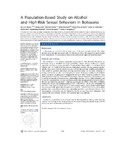A population-based study on alcohol and high-risk sexual behaviors in Botswana

View/
Date
2006-01-01Author
Weiser, S. D.
Leiter, K.
Heisler, M.
McFarland, W.
Percy-de Korte, F.
DeMonner, S. M.
Tlou, S.
Phaladze, N.
Iacopino, V.
Bangsberg, D. R.
Publisher
Public Library of Science, http://www.plos.org/Type
Published ArticleMetadata
Show full item recordAbstract
Background
In Botswana, an estimated 24% of adults ages 15–49 years are infected with HIV. While alcohol use is strongly associated with HIV infection in Africa, few population-based studies have characterized the association of alcohol use with specific high-risk sexual behaviors.
Methods and Findings
We conducted a cross-sectional, population-based study of 1,268 adults from five districts in Botswana using a stratified two-stage probability sample design. Multivariate logistic regression was used to assess correlates of heavy alcohol consumption (>14 drinks/week for women, and >21 drinks/week for men) as a dependent variable. We also assessed gender-specific associations between alcohol use as a primary independent variable (categorized as none, moderate, problem and heavy drinking) and several risky sex outcomes including: (a) having unprotected sex with a nonmonogamous partner; (b) having multiple sexual partners; and (c) paying for or selling sex in exchange for money or other resources. Criteria for heavy drinking were met by 31% of men and 17% of women. Adjusted correlates of heavy alcohol use included male gender, intergenerational relationships (age ≥gap 10 y), higher education, and living with a sexual partner. Among men, heavy alcohol use was associated with higher odds of all risky sex outcomes examined, including unprotected sex (AOR = 3.48; 95% confidence interval [CI], 1.65 to 7.32), multiple partners (AOR = 3.08; 95% CI, 1.95 to 4.87), and paying for sex (AOR = 3.65; 95% CI, 2.58 to 12.37). Similarly, among women, heavy alcohol consumption was associated with higher odds of unprotected sex (AOR = 3.28; 95% CI, 1.71 to 6.28), multiple partners (AOR = 3.05; 95% CI, 1.83 to 5.07), and selling sex (AOR = 8.50; 95% CI, 3.41 to 21.18). A dose-response relationship was seen between alcohol use and risky sexual behaviors, with moderate drinkers at lower risk than both problem and heavy drinkers.
Conclusions
Alcohol use is associated with multiple risks for HIV transmission among both men and women. The findings of this study underscore the need to integrate alcohol abuse and HIV prevention efforts in Botswana and elsewhere.
